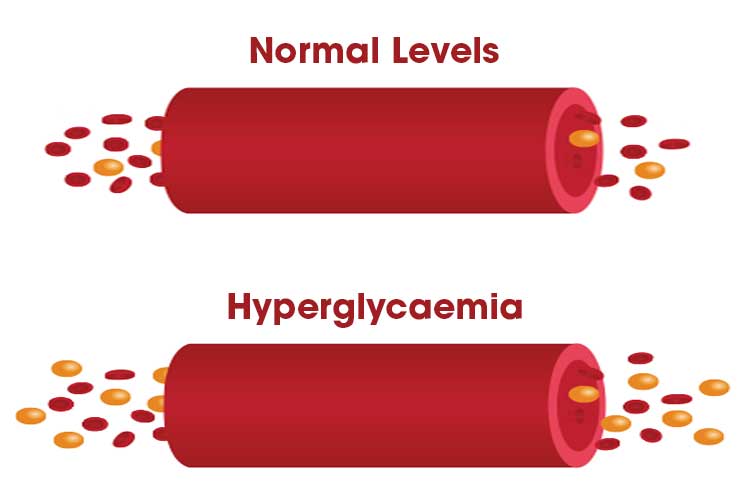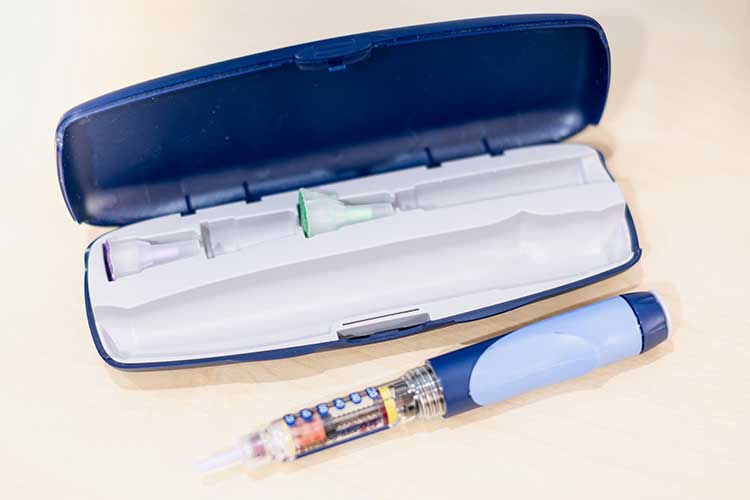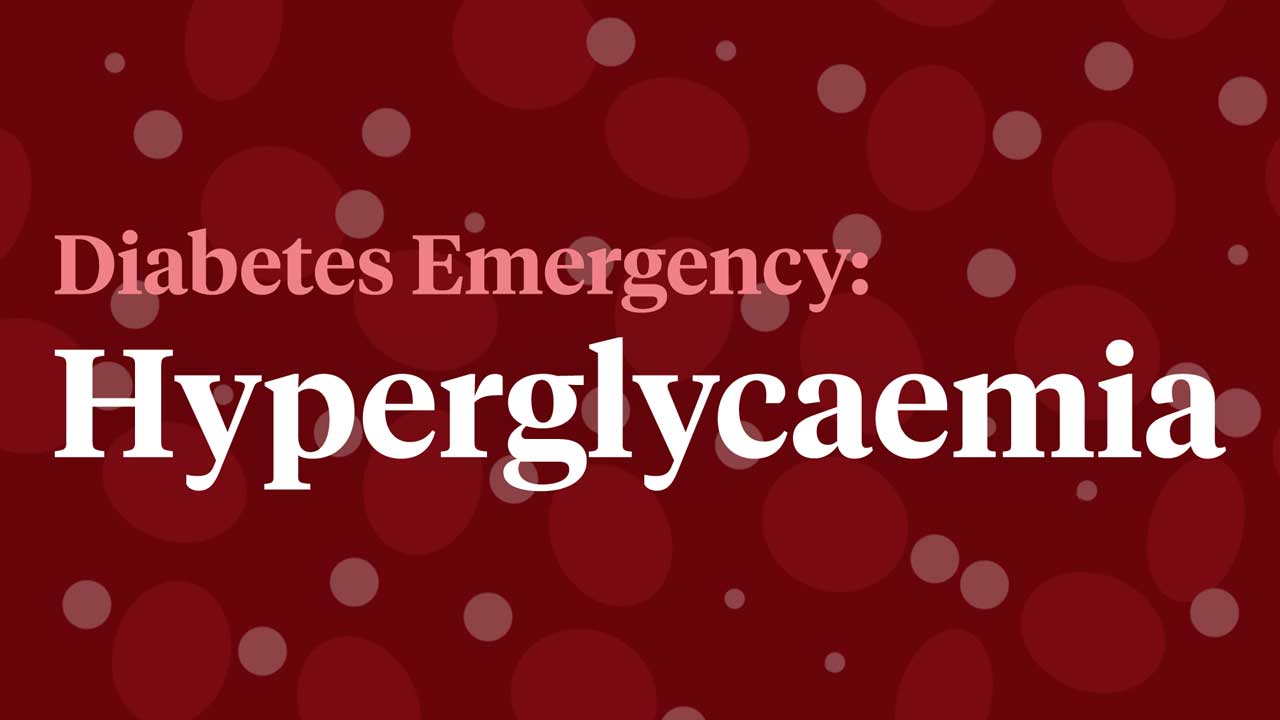What is Hyperglycaemia?
Hyperglycaemia is a condition in which a person presents with an abnormally high level of glucose circulating in their bloodstream (Healthdirect 2022).
Blood glucose levels can rise above target quickly or slowly over time. In the latter, people often do not experience any symptoms until their blood glucose levels reach an extremely high level (Battocchio 2022).
Hyperglycaemia can generally be defined as:
- Blood glucose level > 7.0 mmol/L (126 mg/dl) when fasting
- Blood glucose level > 11.1 mmol/L (200 mg/dl) two hours after meals.
(Diabetes.co.uk 2023)

The Australian Diabetes Society (2012) recommends that most patients admitted with accompanying hyperglycaemia should be treated to achieve and maintain glucose levels less than 10.0 mmol/L.
For people with diabetes who wear continuous glucose monitoring sensors, glycaemic targets can be measured using detailed generated 14-day ambulatory glucose profile reports (Battelino et al. 2019).
| Glucose ranges | Targets [% of readings (time/day)] |
|---|---|
| Greater 13.9mmol/L | Less than 5% (1 hour, 12 minutes) |
| 10.0 – 13.9mmol/L | Less than 25% (6 hours) |
| Time in range 3.9 – 10.0mmo/L | Greater than 70% (16 hours, 48 minutes) |
| Less than 3.9mmol/L | Less than 4% (58 minutes) |
| Less than 3.0mmol/L | Less than 1% (14 minutes) |
(Battelino et al. 2019)
These targets will vary with different cohorts of people with diabetes, including different types of diabetes, ages and pregnancy (Battelino et al. 2019).
Raised HbA1c results (three-month glucose average) are also indicative of hyperglycaemia. For example, the estimated glucose average of a suboptimal HbA1c result of 8% is 10.1 mmol/L and 10% is 13.4 mmol/L (ADA 2019).
What Causes Hyperglycaemia?
Hyperglycaemia can be triggered by:
- Sickness
- Infection
- Injury or surgery
- Stress
- Inactivity
- Excess carbohydrate intake
- Insufficient or ineffective (e.g. expired) or omission of insulin or diabetes medicines
- Incorrect insulin administration technique
- Other medicines such as corticosteroids.
(Battocchio 2022; Healthdirect 2022)
Signs and Symptoms of Hyperglycaemia
Hyperglycaemia can result in clinical symptoms that include:
- Lethargy
- Polyuria
- Polydipsia
- Weight loss (more commonly seen with type 1 diabetes).
Other clinical features can include:
- Frequent fungal or bacterial infections
- Poor wound healing
- Blurred vision
- Loss of sensation (i.e. touch, vibration, cold)
- Dry skin and boils
- Worsening of urinary incontinence (in older people)
- Clinical signs of dehydration.
Such symptoms may be similar to those that occurred when diabetes was originally diagnosed (RACGP 2020).
What are the Risks of Hyperglycaemia?
Prompt treatment of hyperglycaemia is essential, as regularly having high levels of glucose can affect vital organs including the kidneys, eyes and nerves (Better Health Channel 2021).
Raised blood glucose levels can impact on physical energy, which in turn can impact mental wellbeing.
Hyperglycaemia can evolve into medical emergencies that require urgent assessment and management to reduce preventable morbidity. They may present as the first indication of diabetes in undiagnosed people, or as a crisis for those with known diabetes (RACGP & ADS 2018).
Types of Hyperglycaemia Emergencies

A blood glucose level of >15 mmol/L on two subsequent occasions, two hours apart, with the clinical symptoms of metabolic disturbance should be considered a hyperglycaemic emergency that requires assessment and intervention (RACGP 2020).
Hyperglycaemia emergencies fall into two distinct categories: diabetic ketoacidosis (DKA) and hyperosmolar hyperglycaemic state (HHS) - extreme manifestations of impaired carbohydrate regulation that can occur in people with diabetes.
Both DKA and HHS are classified as emergencies. However, mortality is higher in HHS than in DKA - as it often relates to a precipitating condition in an older person (RACGP & ADS 2018).
1. Diabetic Ketoacidosis (DKA)
Diabetic ketoacidosis (DKA) is a life-threatening complication in patients with untreated or mismanaged diabetes.
DKA occurs when excessive amounts of ketone – a type of acid that in large amounts is toxic to the body – are released into the bloodstream as a result of the body breaking down lipids, instead of utilising glucose as the energy source (Hamdy & Khardori 2024; NDSS 2024).
This process is known as gluconeogenesis and occurs when the body does not have sufficient insulin to allow the uptake of glucose from the bloodstream into the cells. It’s observed primarily in people with type 1 diabetes but it can also occur in type 2 diabetes (Hamdy & Khardori 2024; Lizzo et al. 2023).
DKA is more common in younger people and is seen more in females than in males (Hamdy & Khardori 2024).
DKA can cause rapid deterioration and an altered state of consciousness (RACGP & ADS 2018).
Possible symptoms of a hyperglycaemic crisis associated with DKA include:
- Extreme thirst
- Nausea and/or vomiting
- Abdominal pain
- Polyuria
- Weight loss
- Altered state of consciousness
- Ketotic breath (may smell fruity or like acetone)
- Increased respiratory rate (known as Kussmaul breathing)
- Dehydration.
(RACGP & ADS 2018; Lizzo et al. 2023)
2. Hyperosmolar Hyperglycaemic States (HHS) - Formerly Known as Hyperosmolar Non-Ketotic Coma (HONC)
Persistent hyperglycaemia in the absence of ketosis is known as hyperosmolar hyperglycaemia state (HHS). HHS is accompanied by intense dehydration (RACGP & ADS 2018).
HHS is more closely associated with type 2 diabetes and typically affects older patients (RACGP & ADS 2018).
HHS is common in patients who:
- Have acute sepsis
- Have just experienced a cardiovascular event
- Have renal dysfunction.
(RACGP & ADS 2018)
Coma may develop in some patients (RACGP & ADS 2018).
Possible symptoms of a hyperglycaemic crisis associated with HHS include:
- Atypical symptoms, including:
- Pain
- Fever
- Non-specific symptoms (in children), such as:
- Headache
- Weakness
- Vomiting
- Abdominal pain
- Dry mouth
- Thirst
- Cool extremities
- Rapid pulse
- Extreme dehydration
- Reduced urination (oliguria) that may progress to anuria
- Decreased skin turgor
- Altered state of consciousness.
(RACGP & ADS 2018; Stoner 2017)
Who is at Risk of Hyperglycaemia?

People who fall into the following categories should be closely monitored:
- Those who are pregnant (pregnancy is a ketogenic state and hypoglycaemia can occur due to illness, inadequate dietary intake or insulin dosing at lower glucose levels)
- Children and young people with type 1 diabetes - especially those young people transitioning to adult services
- Those who have unstable glycaemic control
- Those omitting diabetes-related medication, especially insulin
- People with type 1 diabetes and disordered eating such as diabulimia
- Those who use an insulin pump (pump malfunctions can result in rapidly rising blood glucose levels due to the use of rapid-acting insulin - there is no long-acting or basal insulin in use)
- Previous or recurrent DKA
- Those with pancreatitis
- Those who have experienced:
- Those with high rates of alcohol or recreational drug consumption
- Older people
- Those taking certain medications such as corticosteroids, atypical antipsychotics and immunosuppressive agents.
(RACGP & ADS 2018; Rudland et al. 2020; Siu Ying Nip & Lodish 2021; NDSS 2021)
Assessing for Hyperglycaemia
A clinical assessment may include the following:
- Blood glucose and blood ketone levels (blood ketone testing is preferred to urine testing)
- Temperature checks
- Blood pressure monitoring
- Heart rate monitoring
- Respiratory rate monitoring
- Neurological assessments such as the Glasgow Coma Scale
- Urgent point-of-care assessment.
(RACGP & ADS 2018)
The biochemical criteria for DKA is:
- The ‘D’ - blood glucose > 11 mmol/L
- The ‘K’ - presence of blood ketone levels ≥ 0.6 mmol/L and > 3.0 mmol/L in severe ketosis
- The ‘A’ - venous pH < 7.3 or bicarbonate < 15 mmol/L.
(RACGP 2020; JBDS-IP 2021)
Treating Hyperglycaemic Emergencies
DKA and HHS must be managed within the hospital setting. Emergency Management Clinical Pathways for adults and children have been developed to assist clinicians from the time of presentation until discharge. These inpatient protocols outline investigations, fluid replacement, insulin administration and other actions required throughout the admission and may differ slightly between various health services (Queensland Government 2023; Children’s Health Queensland 2024).
Preventing Hyperglycaemia

Inadequate insulin treatment (and noncompliance) and infection are the two major precipitating factors in the development of DKA (Hamdy & Khardori 2024).
In many cases, these events may be prevented by:
- Better access to medical care
- Intensive patient education
- Effective communication with a healthcare provider during acute illnesses.
(Gosmanov & Nematollahi 2023)
It’s vital that people with diabetes have a sick day plan and management kit to provide information on managing their diabetes while unwell (Diabetes Australia 2024). Credentialled diabetes educators can assist in formulating individual sick day plans for people with type 1 and 2 diabetes and those who are planning to be or are currently pregnant. These sick day plans should be regularly reviewed and updated especially following an episode of illness. Sick day kits are also a vital part of travel planning (ADEA 2020).
People who present with recurrent DKA may be experiencing fragmented care or social, behavioural or psychological issues. Other risk factors for recurrent DKA can include sex (female), adolescence and low socioeconomic status (JBDS-IP 2021).
Euglycaemic DKA
Euglycaemic DKA is defined as mild or moderate blood glucose elevation (> 11.1 mmol/L) with all other biochemistry criteria for DKA. This can occur in people prescribed SGLT2 inhibitors, people who are pregnant, following excessive alcohol intake, post-surgery/colonoscopy, or in people on extremely low carbohydrate diets. In order to reduce the risk for inpatients, the Australian Diabetes Society’s updated position statement outlines that SGLT2 inhibitors should be omitted for three days pre-procedure (two days prior to surgery and on the day of surgery/procedure) (ADS 2022).
Hyperglycaemic Emergencies in Children and Adolescents
It should be noted that separate guidelines and clinical pathways exist for children who develop DKA and HHS (Children’s Health Queensland 2024) and to assist clinicians in the early recognition of hyperglycaemia in children aged under 16 years (Queensland Health 2021).
Test Your Knowledge
Question 1 of 3
Who among the following is NOT listed as being most at risk of hyperglycaemia?
Topics
References
- Australian Diabetes Educators Association 2020, Clinical Guiding Principles for Sick Day Management of Adults with Type 1 Diabetes or Type 2 Diabetes: A Guide for Health Professionals, National Diabetes Services Scheme, viewed 5 August 2024 https://www.adea.com.au/wp-content/uploads/2020/09/Sickdays-_12.pdf
- Australian Diabetes Society 2022, Alert Update January 2022 with SGLT2 Inhibitor Use in People with Diabetes, ADS, viewed 5 August 2024, https://www.diabetessociety.com.au/downloads/20220121%202021%20ADS%20DKA%20SGLT2i%20Alert%20highlighted%20changes%20Jan%2022.pdf
- Australian Diabetes Society 2012, Guidelines for Routine Glucose Control in Hospital, ADS, viewed 5 August 2024, https://diabetessociety.com.au/documents/ADSGuidelinesforRoutineGlucoseControlinHospitalFinal2012.pdf
- Battelino T, et al. 2019, ‘Clinical Targets for Continuous Glucose Monitoring Data Interpretation: Recommendations From the International Consensus on Time in Range’, Diabetes Care, vol. 42, no. 8, pp. 1593-1603, viewed 5 August 2024, https://diabetesjournals.org/care/article/42/8/1593/36184/Clinical-Targets-for-Continuous-Glucose-Monitoring
- Battocchio, K 2022, Hyperglycaemia – Symptoms, Risks and Management, Diabetes Australia, viewed 5 August 2024, https://www.diabetesaustralia.com.au/living-with-diabetes/managing-your-diabetes/hyperglycaemia/
- Better Health Channel 2021, Diabetes - Long-term Effects, Victoria State Government, viewed 5 August 2024, https://www.betterhealth.vic.gov.au/health/conditionsandtreatments/diabetes-long-term-effects
- Children’s Health Queensland 2024, Diabetic Ketoacidosis (DKA) and Hyperosmolar Hyperglycaemia State (HHS) - Emergency Management in Children, Queensland Government, viewed 5 August 2024, https://www.childrens.health.qld.gov.au/guideline-dka-emergency-management-in-children/
- Clinical Excellence Queensland 2021, Early Recognition of Hyperglycaemia in Children Under 16 Years, Queensland Government, viewed 5 August 2024, https://clinicalexcellence.qld.gov.au/sites/default/files/2021-02/Early_recognition_hyperglycaemia_children_under16.pdf
- Diabetes Australia 2024, Sick Day Management, Diabetes Australia, viewed 5 August 2024, https://www.diabetesaustralia.com.au/sick-day-management/
- Diabetes.co.uk 2023, Hyperglycemia, Diabetes.co.uk, viewed 5 August 2024, https://www.diabetes.co.uk/Diabetes-and-Hyperglycaemia.html
- Gosmanov, A R & Nematollahi, LR 2023, ‘Diabetic Ketoacidosis’, BMJ Best Practice, viewed 5 August 2024, https://bestpractice.bmj.com/topics/en-us/162
- Hamdy, O & Khardori, R 2024, Diabetic Ketoacidosis (DKA), Medscape, viewed 5 August 2024, https://emedicine.medscape.com/article/118361-overview
- Healthdirect 2022, Hyperglycaemia (High Blood Sugar), Australian Government, viewed 5 August 2024, https://www.healthdirect.gov.au/hyperglycaemia-high-blood-sugar
- Holt, RIG et al. 2021, ‘The Management of Type 1 Diabetes in Adults. A Consensus Report by the American Diabetes Association (ADA) and the European Association for the Study of Diabetes (EASD)’, Diabetologia, 2021, vol. 64, no. 12, pp. 2609-2652, viewed 5 August 2024, https://link.springer.com/article/10.1007/s00125-021-05568-3
- Joint British Diabetes Societies for Inpatient Care 2021, The Management of Diabetic Ketoacidosis in Adults, JBDS-IP, viewed 5 August 202,4 https://diabetes-resources-production.s3.eu-west-1.amazonaws.com/resources-s3/public/2021-06/JBDS%2002%20DKA%20Guideline%20amended%20v2.pdf
- Lizzo, JM, Goyal, A & Gupta, V 2022, ‘Adult Diabetic Ketoacidosis’, StatPearls, viewed 5 August 2024, https://www.ncbi.nlm.nih.gov/books/NBK560723/
- National Diabetes Service Scheme 2021, Diabetes and Disordered Eating, Diabetes Australia, viewed 5 August 2024, https://www.ndss.com.au/wp-content/uploads/fact-sheets/fact-sheet-diabetes-and-disordered-eating.pdf
- National Diabetes Services Scheme 2024, Ketoacidosis, Diabetes Australia, viewed 5 August 2024, https://www.ndss.com.au/living-with-diabetes/management-and-care/ketoacidosis/
- Queensland Government 2023, Management of Diabetic Acidosis in Adults (Age 16 Years and Over), Queensland Government, viewed 5 August 2024 https://www.health.qld.gov.au/__data/assets/pdf_file/0028/438391/diabetic-ketoacidosis.pdf
- Royal Australian College of General Practitioners 2020, Management of Type 2 Diabetes: A Handbook for General Practice, RACGP, viewed 5 August 2024, https://www.racgp.org.au/getattachment/41fee8dc-7f97-4f87-9d90-b7af337af778/Management-of-type-2-diabetes-A-handbook-for-general-practice.aspx
- Royal Australian College of General Practitioners & Australian Diabetes Society 2018, Emergency Management of Hyperglycaemia in Primary Care, RACGP, viewed 5 August 2024, https://www.racgp.org.au/clinical-resources/clinical-guidelines/key-racgp-guidelines/emergency-management-of-hyperglycaemia
- Rudland, VL et al. 2020, ‘ADIPS 2020 Guideline for Pre-Existing Diabetes and Pregnancy’, ANZJOG, vol. 60, no. 6, viewed 5 August 2024 https://obgyn.onlinelibrary.wiley.com/doi/epdf/10.1111/ajo.13265
- Siu Ting Nip, A & Lodish, M 2021, ‘Trend of Diabetes-Related Hospital Admissions During the Transition Period From Adolescence to Adulthood in the State of California’, Diabetes Care, vol. 44, no. 12, pp. 2723-2728, viewed 5 August 2024, https://diabetesjournals.org/care/article-abstract/44/12/2723/138484/Trend-of-Diabetes-Related-Hospital-Admissions?redirectedFrom=fulltext
- Stoner, G D 2017, ‘Hyperosmolar Hyperglycemic State’, American Family Physician, vol. 96, no. 11, viewed 5 August 2024, https://www.aafp.org/pubs/afp/issues/2017/1201/p729.html
 New
New 
